Two way switches. In this tutorial we’re going to be looking at how to control a light fitting with 2 switches. This is very useful for example placing a light switch at the top and bottom of a set of stairs or at different doors of a room.
Scroll to the bottom to watch the YouTube tutorial video on two way switching
We’ll look at some common variations on how to do this. The colour of cables varies around the world according to different standards, I’m using the European colour code for this video but you should check your local regulations.
Warning
Electricity is dangerous, we’re covering the theory in this tutorial, please do not undertake any electrical work unless you are qualified and competent. Never work on live circuits.
So to control a light with two switches we of course need two switches which have 3 terminals on the back.
The name for these types of switches is different depending on where you are in the world.
The US calls these three way switches and the EU calls these two way switches.
See our tutorial on US/Canada three way switching here

The switch can be flipped only two ways, up or down, but If you look on the back you’ll see there are three terminals and there are four ways for the electricity to flow, depending on how the switch is wired. One terminal is called the common and then we have a terminal called line 1 and another terminal called line 2.
Method 1
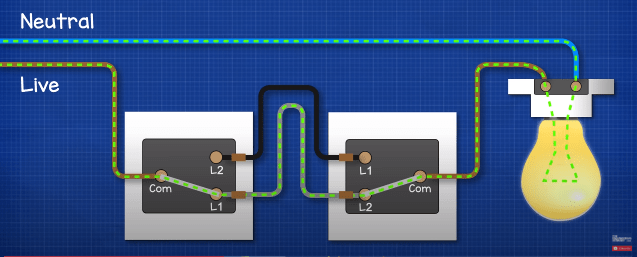
So we have the electricity coming in from a consumer unit and feeding the light fitting.
We therefore take the live wire and divert this into the common terminal of switch one. We run another wire from the common terminal of switch 2 and connect this to the lamp.
We now need to connect the two switches so we connect terminal L1 on switch one with terminal L2 on switch 2. We need to place a brown sleeve at each end of this wire to warn that it is intermittently live.
We then run another wire from terminal L2 of switch one and connect this to terminal L1 of switch 2. Again placing a brown sleeve to indicate that it can be live.
When switch one is on but switch 2 is off. The electricity can make it through switch one and into switch two but the circuit is broken at switch two. If we then flip switch two, the circuit is complete so electricity runs through the entire circuit and the lamp lights up.
If we then flip switch one, the circuit is broken again so the lamp turns off, but electricity still flows to switch two where the circuit is broken. We could flip switch one again to compete the circuit. Or we can flip switch two and the circuit is complete also.
So we can therefore flip either switch 1 or switch 2 to make or break the circuit and thus control the light using two switches.
Method 2
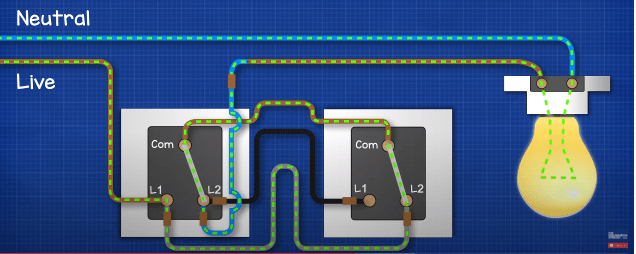
The second common way to control a light with two switches is to convert a one way switch circuit to a two way.
We again need two switches and you need to check the back to ensure they have 3 terminals on each. If your one way switch only has two terminals then you’ll need to replace this.
So we run the live wire into terminal L1 of switch 1.
We then run a grey wire from terminal L1 of switch 1 to terminal L2 of switch 2. We need to place a brown sleeve at either end to warn that this is intermittently live.
We run a brown wire between the two common terminals of both switches.
Then we run the black wire from terminal L2 of switch 1 to terminal L1 of switch 2. Again we need to place a brown sleeve at each end to warn that this is intermittently live.
Lastly to complete the circuit, we connect terminal L2 back to the supply for the light fitting. Again using a brown sleeve to warn it’s intermittently live.
When switch 1 is on but switch 2 is off. Electricity can pass through switch 1 and into switch 2 where the circuit is broken. If we flip switch two we complete the circuit so the electricity can flow through the common and out into the lamp.
If we flip switch 1 we break the circuit to the light fitting so the lamp turns off.
If we then flip switch 2 we make the circuit again and the electricity will flow to the light fitting.
Alternative way 1

The alternative way works almost identically to “Method 2” we just saw. But in this method we run the live to L2 of switch 1
Then we run a brown cable from L2 of switch 1 over to L1 of switch 2
Then we run the grey wire from L2 of switch 2 over to L1 of switch 1, we need to place a brown sleeve at each end to warn that it is intermittently live.
Then we run a black wire between both commons of both switches, again we need to place a brown sleeve at each end.
Finally we connect the blue wire from L1 of switch 1 back to the light fitting. Again we place a brown sleeve at each end.
So to start with, the circuit it broken so the electricity passes through switch 1 and into switch 2, but it reaches a dead end. If we then flip switch 1, we complete the circuit and electricity can flow through switch 1, into switch 2 then back to switch 1 and up into the lamp.
If we flip switch 2, we break the circuit, electricity just flows between the two switches and doesn’t reach the light.
If we flip switch 1, then electricity can flow into switch 1, over into switch 2, across the switch and back over to switch 1 where it can flow to the light.
Alternative way 2
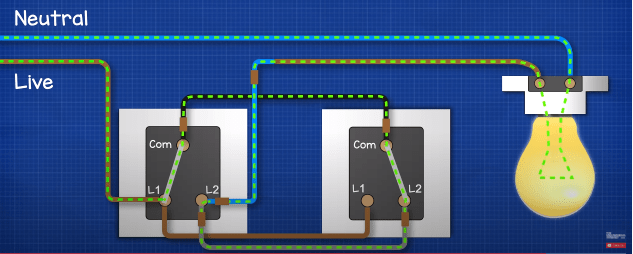
On the 2nd we connect the live to L1 of switch 1, then run a brown wire between L1 of switch 1 to L1 of switch 2. Then we run a grey wire between L2 of switch 2 and L2 of switch 1, then we run the black wire between the two commons and finally we connect the blue wire between L2 of switch 1 and the lamp. Remember to add a brown sleeve to all the cables to warn that they are intermittently live.
Alternative way 3

The 3rd variation is very similar to the last one except the black wire is connected between the two L1’s of both switches and the brown wire is connected across the two commons. Again place a brown sleeve on the wires to indicate that they are intermittently live.

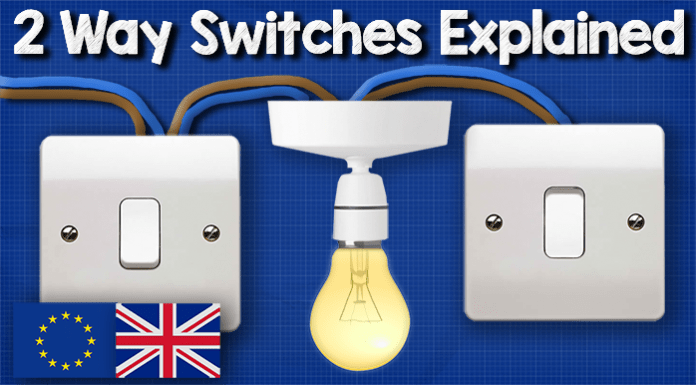




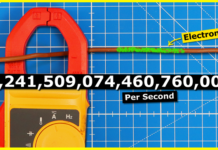





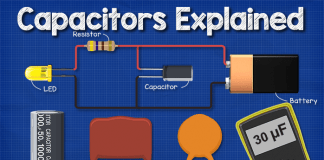









Hello,
loved the vids and very clear to understand.
im trying to replace my 2 corridor basic switches ( one at the entrance if the flat and one at the end of the corridor) with varilight dimmers but not luck so far. I can only get one to work ( on /off and dim the light but when i put the other dimmer on the other place it wont work anymore, even using master and slave dimmers.
is there a solution to this?
one electrician off the net came but couldnt make them work…
help!
Francesco
Is it just me or have the videos been purged from Giphy?
Not just you – all animations now unavailable 🙁